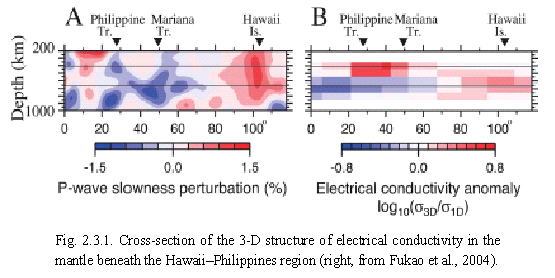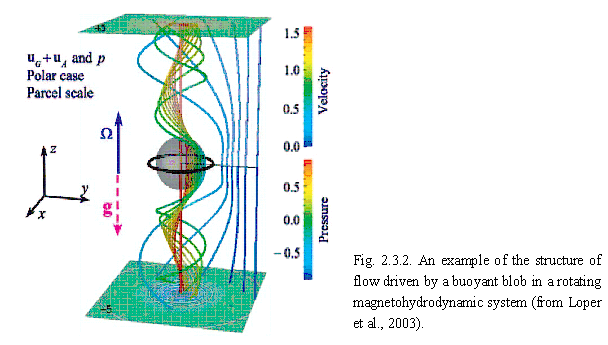| We studied the electrical conductivity structure of the upper mantle and
uppermost part of the lower mantle beneath the Pacific region using magnetic
field observatory data and newly obtained electromagnetic field data from
the OHP (see Section 2-5). Our findings indicate the importance of the
effect of land-sea conductivity contrast in obtaining proper structures
(Fujii and Utada, 2000). This implies that the electromagnetic induction
problem is inherently a 3-D one related to the effect of seawater, even
if a 1-D mantle is assumed. We developed computer codes that model global
and semi-global electromagnetic induction in a 3-D medium based on an integral
equation method; these models are utilized to obtain PREM-like 1-D reference
conductivity structure beneath the Pacific (Utada et al., 2003) and for
the first successful 3-D inversion of semi-global electrical conductivity
structure in the mantle (Koyama, 2002; Fig. 2.3.1). |
 |
| It is well known that the toroidal magnetic field must exist in the Earthfs
core in order for it to be a dynamo, although the component is confined
in the core. Although the field cannot be detected by magnetic field observations
at the surface of Earth, its signature is present in the geo-electric field
and can possibly be detected by electric field observations using cables
at the scale of thousands of kilometers. We began geo-electric field observations
in the northwest Pacific with the aim of detecting the signature of the
toroidal field (see Section 2-5). Long-term (decade-scale) variations in
electric potential obtained to date indicate that decade-scale variation
in the toroidal magnetic field at the core mantle boundary is 1?10 times
that of the poloidal field variation, with reasonable electrical conductivity
of the mantle (Shimizu et al., 1998). We confirmed that the amplitude is
consistent with the electrodynamics of the geodynamo (Shimizu and Utada,
2004). |
| We are studying the small-scale magnetohydrodynamics within a rotating system as a step towards obtaining better parameterization of subgrid scale phenomena, especially the mean-field electromotive force, and establishing more realistic geodynamo models as a joint project with David E. Loper (Florida State University, USA) and Arnaud Chulliat (Institut de Physique du Globe de Paris, France). Structures of the flow and magnetic field driven by a buoyant blob are classified based on the strength of the rotation of the system and the magnetic field (Shimizu and Loper, 1997); detailed structures are obtained for the case of rapid rotation that is appropriate for the Earthfs core (Loper et al., 2003; Chulliat et al., 2004; Fig. 2.3.2). Although the integral of the electromotive force to the flow and field over entire space is zero, it has a significant non-zero value when integrated over the cross-section of the Taylor column, and it is significantly anisotropic (Shimizu and Loper, 2000; Chulliat et al., 2003, 2004). |
 |
| The problem of the state of the inner core boundary (ICB), whether a mushy
layer or a slurry layer, is revisited as a new joint research project with
J.-L. LeMouel and J.-P. Poirier (Institut de Physique du Globe de Paris,
France). Stability analysis of the solid-liquid interface indicates that
the condition that leads to a slurry layer does exist, but it cannot be
attained within the Earthfs core; it is most probable that a mushy layer
exists at the ICB. |
| Determining core surface flow by inverting geomagnetic secular variation with a frozen flux assumption has unavoidable physical non-uniqueness. We studied the use of length of the day (l.o.d.) data to overcome the non-uniqueness by assuming topographic (Asari et al., 2006) or electromagnetic core?mantle coupling. Cylindrical torque, which should be balanced in decade-scale core dynamics, is additionally considered both as a constraint to reduce the non-uniqueness and to obtain dynamically appropriate core surface flow (Asari, 2006). We found that only topographic core?mantle coupling is compatible with decadal cylindrical core dynamics. |

